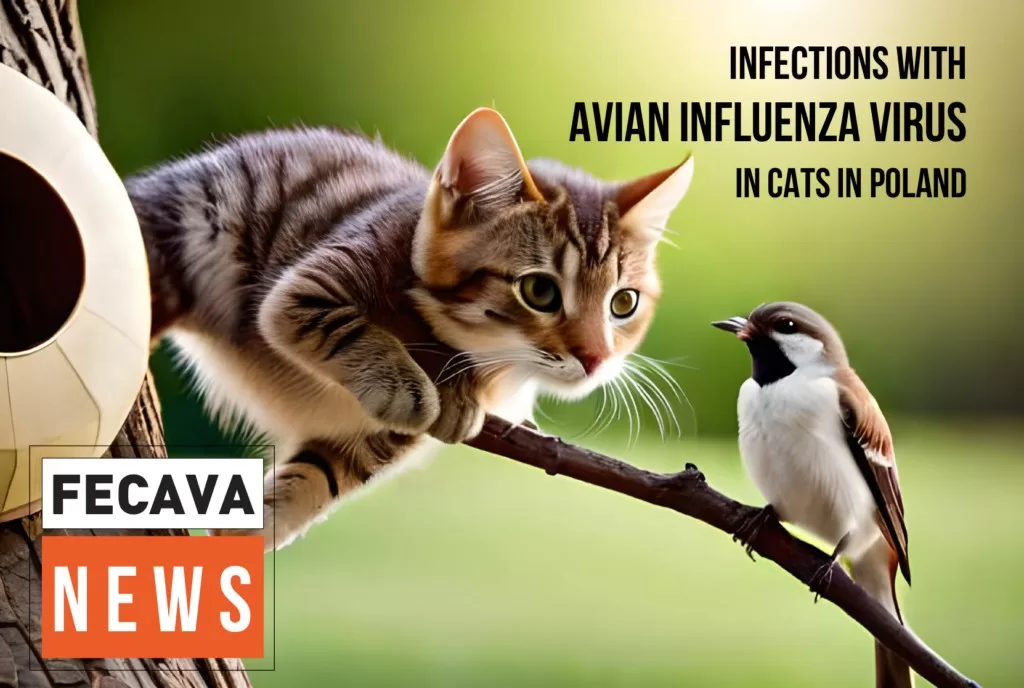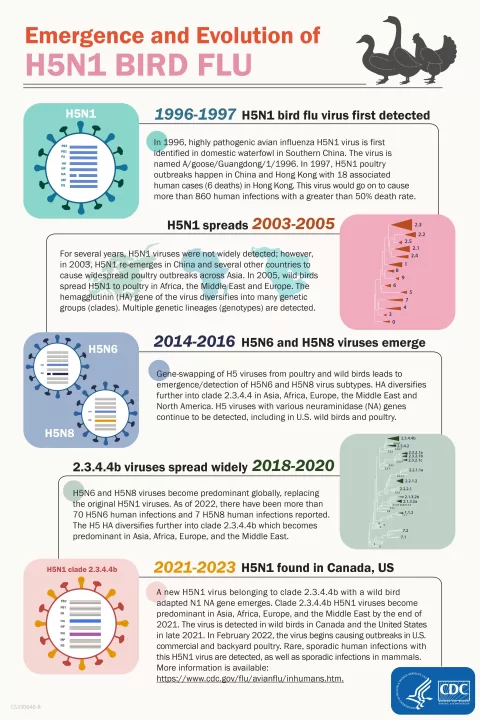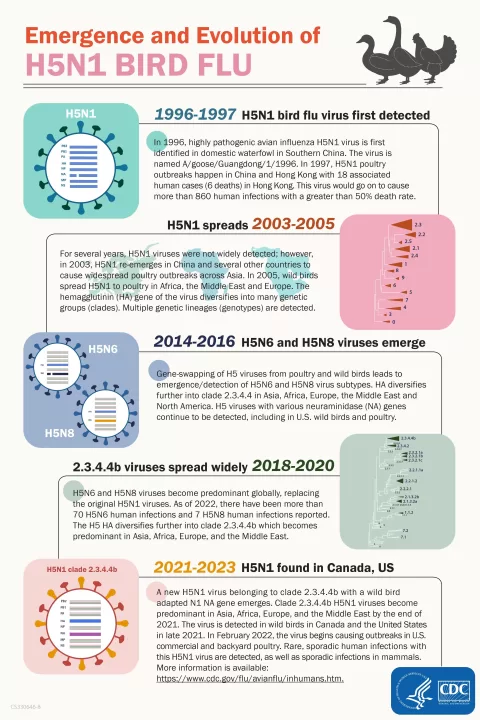H5N1 bird flu in cats is becoming an alarming health issue as it spreads across 23 states in the U.S., with domestic cats proving to be particularly susceptible to this avian influenza virus. Pet owners are advised to be vigilant about recognizing bird flu symptoms in cats, such as lethargy and difficulty breathing, to ensure prompt veterinary care. Preventing bird flu in pets starts with maintaining a safe environment to limit exposure to infected birds and contaminated substances. The recent transmission of H5N1 in cats raises concerns over the potential cat health risks, especially since infected felines can transmit the virus to humans and other animals. With careful monitoring and preventive measures, pet owners can protect their furry companions from this dangerous strain of avian influenza.
The recent uptick in avian influenza in domestic cats, specifically the H5N1 strain, has sparked widespread concern among pet owners and veterinary professionals alike. Often referred to as bird flu, this viral infection can lead to serious health complications for our feline friends, making awareness essential. Cat guardians must familiarize themselves with the signs of bird flu to ensure quick intervention, as well as implement strategies for preventing bird flu in pets. With cases of H5N1 transmission in cats documented, there is an urgent need to address the cat health risks associated with this virus. Understanding avian influenza in domestic cats is critical to safeguarding their well-being and the health of humans interacting with them.
Understanding H5N1 Bird Flu in Cats
H5N1 bird flu is a significant concern for pet owners, especially as domestic cats become increasingly involved in outbreaks. The avian influenza virus, initially known for its impact on birds, has now mutated, gaining the ability to infect cats more easily. With over 130 confirmed cases in the U.S. alone, the implications for cat health are alarming. Cats can contract the virus in various ways, such as direct contact with infected wildlife or through raw poultry-based diets, making awareness crucial for prevention.
Understanding H5N1 transmission in cats helps pet owners take preventative steps. Symptoms can range from lethargy to severe respiratory distress, often leading to high mortality rates. This emphasizes the need for vigilance on the part of cat owners. Keeping cats indoors, monitoring their health, and maintaining a clean environment can significantly reduce the risks associated with this avian influenza strain.
Identifying Bird Flu Symptoms in Cats
Recognizing bird flu symptoms in cats is vital for early intervention. Infected cats often display a range of clinical signs including fever, apathy, and respiratory issues such as difficulty breathing and nasal discharge. These symptoms, if not addressed swiftly, can escalate into more severe complications. Cat owners are urged to remain observant, especially if their pets have been exposed to environments with wild birds or other potential carriers of the virus.
Notably, neurological symptoms can also manifest, sometimes leading to tremors or seizures in severely affected cats. Owners should act quickly and consult a veterinarian if they notice these symptoms, particularly if there’s been any potential exposure to H5N1 through raw meats or wild animal interactions. Timely veterinary advice can be crucial in managing the health risks to their cats.
Preventing Bird Flu in Pets
Preventing bird flu in cats and other pets requires a proactive approach. Pet owners should ensure their cats avoid contact with wild birds and other wildlife, which are often the primary carriers of the H5N1 virus. Educating oneself about safe feeding practices is also essential. For example, avoiding raw poultry diets and ensuring that cat food is sourced from reputable suppliers can mitigate risks significantly.
Additionally, proper hygiene practices are crucial. Washing hands, changing clothes, and maintaining a clean space after potential exposure to infected animals can help protect pets. Regular veterinary check-ups and vaccinations for other diseases can further enhance overall cat health and immune responses, establishing a safer environment for pets to thrive.
Understanding H5N1 Transmission in Cats
H5N1 transmission in cats occurs through various means, including eating infected birds or raw poultry-based diets. Cats can also become infected by coming into contact with contaminated surfaces or by interacting with wildlife. With a documented history of mammalian transmission, it is critical for pet owners to understand these modes of infection to preemptively guard their cats against this serious strain of avian influenza.
Awareness of H5N1 transmission risk extends beyond just direct contact; it encompasses environmental factors as well. Cats living on or near farms, or those that roam freely, could face higher risks of exposure to H5N1. By limiting outdoor access and monitoring feeding practices, pet owners can greatly decrease their cat’s chances of contracting the virus, thus protecting the health of their feline companions and their families.
Cats at Risk: Cat Health Risks Related to H5N1
The emergence of H5N1 bird flu highlights significant health risks for domestic cats. The virus does not just affect birds; its adaptation to mammals poses a serious threat to cat health. Symptoms of infection range from mild respiratory issues to severe neurological problems, which can lead to fatal outcomes. With domestic cats being highly social companions, the risk of not only individual infection but also potential human transmission adds another layer of concern.
Furthermore, the high mortality rate associated with H5N1 infections means that understanding the cat health risks related to this virus is essential. Pet owners must stay informed about potential environmental hazards, such as the presence of wild birds and unsourced poultry products in their cats’ diets. Proactive education and preventive measures are the best strategies to safeguard feline health and prevent further spread of the virus.
Identifying and Managing Risks in Cat Health
Effective management of cat health risks includes identifying areas where exposure can occur. Pet owners should be aware of their cat’s environment, especially if they reside in regions where H5N1 is prevalent. Noticeable symptoms indicating bird flu, such as lethargy, fever, and respiratory distress, should prompt immediate veterinary attention. Cat owners should also keep a close watch for any changes in behavior or appetite that could signal health concerns.
In addition, owners should implement strategic management strategies, such as enhancing indoor living conditions to limit outdoor exposure. Keeping litter boxes clean, avoiding the feeding of raw animal products, and educating themselves on local wildlife behaviors can significantly reduce health risks for their cats. Regular veterinary check-ups are also essential to monitor and maintain overall health in this context.
The Role of Veterinarians in Bird Flu Awareness
Veterinarians play a crucial role in raising awareness about bird flu in cats and its potential dangers. They serve as the first line of defense in diagnosing and treating infections like H5N1. Educating cat owners on bird flu symptoms and preventive measures can dramatically improve early detection and reduce mortality rates. This includes sharing insights on how cats can contract the virus and the best practices for minimizing risks.
Moreover, veterinarians can advocate for ongoing research and surveillance concerning avian influenza in domestic pets. By staying informed about recent findings and emerging trends, they can better equip pet owners with the necessary knowledge to protect their feline friends, ultimately contributing to the broader public health efforts against zoonotic diseases.
Raw Diets: A Risk Factor for H5N1
Feeding cats a raw diet can present significant risks, particularly regarding H5N1 bird flu. While some pet owners advocate for raw diets due to their perceived benefits, they also expose their pets to various pathogens, including avian influenza. Cats fed raw poultry or fish are particularly vulnerable to infections as these foods can harbor the virus if not sourced and handled correctly.
To mitigate risks, owners should consider cooked alternatives that provide a balanced diet while eliminating the threat of H5N1 and other pathogens. Consulting with a veterinarian about safe feeding practices can help ensure the health of pets without exposing them to potentially lethal viruses. Awareness of the dangers associated with raw diets can be a game changer in protecting the health and safety of domestic cats.
Environmental Risks Associated with H5N1
Environmental factors play a significant role in the spread of H5N1 among domestic cats. Areas with a high presence of wild birds are particularly risky, as these birds are the primary carriers of the virus. Cats that roam outside or are allowed to hunt are at an increased risk of contracting the virus through direct contact with wild species or environmental contamination. It is essential for pet owners to be mindful of these environmental variables to protect both their pets and local fauna.
Additionally, maintaining a clean and controlled environment can help curb potential outbreaks. Implementing restricted outdoor access, reducing exposure to wild birds, and ensuring proper hygiene practices after outdoor activities can effectively mitigate risks. Educating communities about the importance of environmental stewardship also plays a pivotal role in reducing H5N1 transmission opportunities, highlighting the interconnectedness of ecological health and pet safety.
Frequently Asked Questions
What are the bird flu symptoms in cats and how do they indicate H5N1 infection?
Bird flu symptoms in cats can be severe and life-threatening. Infected cats often exhibit lethargy, fever, loss of appetite, difficulty breathing, discharge from the eyes and nose, and neurological issues like tremors or seizures. If your cat shows any of these symptoms, especially after exposure to raw meat or birds, contact your veterinarian immediately.
How does H5N1 transmission in cats occur, and what are the main routes of infection?
H5N1 transmission in cats primarily occurs through consuming raw poultry products, exposure to infected wild birds, and contact with contaminated environments. Cats can become infected by eating dead birds or coming into contact with contaminated surfaces, such as shoes and clothing, particularly after visits to areas where infected animals are present.
What steps can be taken for preventing bird flu in pets, especially for cats?
To prevent bird flu in pets, particularly cats, avoid feeding them raw meat or milk, keep them away from wild birds and poultry, and do not allow them to roam freely outside where they might encounter infected wildlife. Regular handwashing after interacting with other animals and changing clothes before handling your pets can also reduce risks.
What are the cat health risks associated with H5N1 avian influenza?
The cat health risks associated with H5N1 avian influenza are significant, as infections can lead to serious illness or death. The mortality rate in infected cats is high, and there are currently no antiviral treatments available, making early detection and prevention crucial for protecting your feline companions.
Are there any vaccines available for H5N1 bird flu in cats?
Currently, there are no vaccines available for H5N1 bird flu in cats or other domestic pets. Consequently, pet owners should focus on preventative measures, such as limiting exposure to potential sources of infection, to keep their cats safe from avian influenza.
Can bird flu in cats pose a risk to human health?
Yes, bird flu in cats can pose a risk to human health. There has been evidence of cat-to-human transmission of influenza viruses, raising concerns that H5N1 transmitted from infected cats could potentially infect humans. This emphasizes the importance of monitoring and protecting pets from avian influenza.
What should I do if I suspect my cat has bird flu symptoms?
If you suspect your cat has bird flu symptoms, such as lethargy, difficulty breathing, or discharge from the nose and eyes, contact your veterinarian immediately. Provide them with information about any potential exposure to raw meat, wild birds, or other animals to help with diagnosis and care.
| Key Point | Details |
|---|---|
| H5N1 Bird Flu Cases | 130 cases confirmed in domestic cats across 23 states, including Illinois. |
| Transmission Risk | Cats can contract H5N1 through consumption of infected birds, raw meats, or exposure to contaminated environments. |
| Symptoms in Cats | Symptoms include lethargy, fever, respiratory issues, and neurological problems. |
| Prevention Measures | Avoid feeding raw meat or milk, prevent contact with wild birds, and ensure good hygiene after interacting with animals. |
Summary
H5N1 bird flu in cats poses a significant health risk as the virus has been found in domestic felines across multiple states. With 130 confirmed cases in U.S. cats, pet owners must be vigilant in protecting their pets and themselves. Understanding how cats contract H5N1, recognizing the symptoms, and implementing prevention strategies are crucial to reducing the spread of this potentially life-threatening disease.
The content provided on this blog (e.g., symptom descriptions, health tips, or general advice) is for informational purposes only and is not a substitute for professional medical advice, diagnosis, or treatment. Always seek the guidance of your physician or other qualified healthcare provider with any questions you may have regarding a medical condition. Never disregard professional medical advice or delay seeking it because of something you have read on this website. If you believe you may have a medical emergency, call your doctor or emergency services immediately. Reliance on any information provided by this blog is solely at your own risk.








